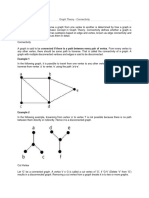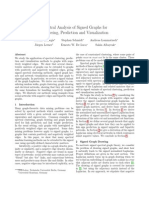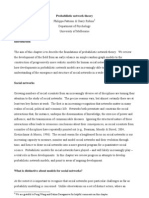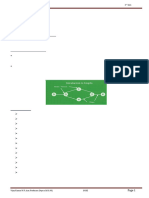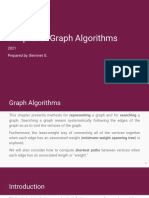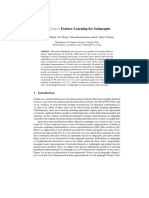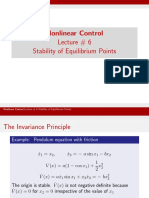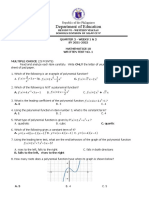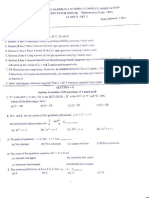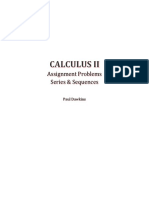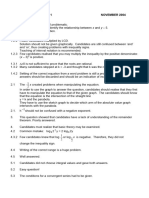0 ratings0% found this document useful (0 votes)
62 viewsUNIT III Directed Paths and Connectedness
UNIT III Directed Paths and Connectedness
Uploaded by
yashnaik7664This document discusses strong and weak connectedness in directed graphs. [1] Strong connectedness means there is a path between every pair of vertices, while weak connectedness means the underlying undirected graph is connected. [2] An example graph is given that is weakly but not strongly connected. [3] Removing an edge can cause a graph to lose both strong and weak connectedness.
Copyright:
© All Rights Reserved
Available Formats
Download as PDF, TXT or read online from Scribd
UNIT III Directed Paths and Connectedness
UNIT III Directed Paths and Connectedness
Uploaded by
yashnaik76640 ratings0% found this document useful (0 votes)
62 views2 pagesThis document discusses strong and weak connectedness in directed graphs. [1] Strong connectedness means there is a path between every pair of vertices, while weak connectedness means the underlying undirected graph is connected. [2] An example graph is given that is weakly but not strongly connected. [3] Removing an edge can cause a graph to lose both strong and weak connectedness.
Original Title
UNIT III Directed paths and connectedness
Copyright
© © All Rights Reserved
Available Formats
PDF, TXT or read online from Scribd
Share this document
Did you find this document useful?
Is this content inappropriate?
This document discusses strong and weak connectedness in directed graphs. [1] Strong connectedness means there is a path between every pair of vertices, while weak connectedness means the underlying undirected graph is connected. [2] An example graph is given that is weakly but not strongly connected. [3] Removing an edge can cause a graph to lose both strong and weak connectedness.
Copyright:
© All Rights Reserved
Available Formats
Download as PDF, TXT or read online from Scribd
Download as pdf or txt
0 ratings0% found this document useful (0 votes)
62 views2 pagesUNIT III Directed Paths and Connectedness
UNIT III Directed Paths and Connectedness
Uploaded by
yashnaik7664This document discusses strong and weak connectedness in directed graphs. [1] Strong connectedness means there is a path between every pair of vertices, while weak connectedness means the underlying undirected graph is connected. [2] An example graph is given that is weakly but not strongly connected. [3] Removing an edge can cause a graph to lose both strong and weak connectedness.
Copyright:
© All Rights Reserved
Available Formats
Download as PDF, TXT or read online from Scribd
Download as pdf or txt
You are on page 1of 2
UNIT III Directed Paths and Connectedness
-----------------------------------------------------------------------------------------------
Asst. Prof. D.R. Khadapkar
GEC, Information Technology & Engineering
Connectedness of a Directed Graph
When dealing with directed graphs, we define two kinds of
connectedness, strong and weak. Strong connectedness of a directed
graph is defined as follows:
Definition (Strong Connectedness of a Directed Graph) A directed
graph is strongly connected if there is a path in G between
every pair of vertices in .
For example, Figure shows the directed graph given by
Notice that the graph is not connected! E.g., there is no path from
any of the vertices in to any of the vertices in .
Nevertheless, the graph ``looks'' connected in the sense that it is not
made of up of separate parts in the way that the graph in Figure is.
This idea of ``looking'' connected is what weak
connectedness represents. To define weak connectedness, we need to
introduce first the notion of the undirected graph that underlies a
directed graph: Consider a directed graph . The underlying
undirected graph is the graph where represents the set of
undirected edges that is obtained by removing the arrowheads from
the directed edges in G:
Figure: A Weakly Connected Directed Graph and the Underlying
Undirected Graph
Weak connectedness of a directed graph is defined with respect to its
underlying, undirected graph:
Definition (Weak Connectedness of a Directed Graph) A directed
graph is weakly connected if the underlying undirected
graph is connected.
For example, since the undirected graph in Figure is connected, the
directed graph is weakly connected. Consider what happens when
we remove the edge (b,e) from the directed graph . The underlying
undirected graph that we get is in Figure. Therefore, when we
remove edge (b,e) from , the graph that remains is neither strongly
connected nor weakly connected.
A traversal of a directed graph (either depth-first or breadth-first)
starting from a given vertex will only visit all the vertices of an
undirected graph if there is a path from the start vertex to every other
vertex. Therefore, a simple way to test whether a directed graph is
strongly connected uses traversals--one starting from each vertex
in . Each time the number of vertices visited is counted. The graph is
strongly connected if all the vertices are visited in each traversal.
You might also like
- Graph Theory (US06CMTH05) - Unit - 4 - Web PDFDocument22 pagesGraph Theory (US06CMTH05) - Unit - 4 - Web PDFSruthi SuhiNo ratings yet
- Graphs Using Adjacency Matrix and ListDocument12 pagesGraphs Using Adjacency Matrix and ListVinu VargheseNo ratings yet
- Reviewer MS 121 FinalDocument11 pagesReviewer MS 121 FinalRodver Angelo EsperaNo ratings yet
- Module 5 - Chapter 9 - Graphs and Algorithms - MSDS 6203 Data Systems and Algorithms N2ADocument12 pagesModule 5 - Chapter 9 - Graphs and Algorithms - MSDS 6203 Data Systems and Algorithms N2AizzieapptestNo ratings yet
- ConnectivityDocument8 pagesConnectivityfab vifNo ratings yet
- Cutsets and CutverticesDocument7 pagesCutsets and CutverticesTerimaaNo ratings yet
- Spectral Analysis of Signed Graphs For Clustering, Prediction and VisualizationDocument12 pagesSpectral Analysis of Signed Graphs For Clustering, Prediction and Visualizationsrinivas1956No ratings yet
- Probabilistic Network TheoryDocument36 pagesProbabilistic Network TheoryAbhijit OmNo ratings yet
- Lecture 13Document8 pagesLecture 13k224403No ratings yet
- 5 Minimal I-Maps, Chordal Graphs, Trees, and Markov ChainsDocument8 pages5 Minimal I-Maps, Chordal Graphs, Trees, and Markov ChainsAdheshNo ratings yet
- Connectivity (Graph Theory) PDFDocument5 pagesConnectivity (Graph Theory) PDFmarsNo ratings yet
- Tutorial On Spectral ClusteringDocument26 pagesTutorial On Spectral Clusteringlennon757No ratings yet
- Graph AnalyticsDocument17 pagesGraph Analyticsmesay83No ratings yet
- 6.1. Intro. To GraphsDocument31 pages6.1. Intro. To GraphsggttffNo ratings yet
- GraphsDocument20 pagesGraphsIshka InsafNo ratings yet
- GraphDocument18 pagesGraphpreritsinghcr7No ratings yet
- Graphs: Data Structures and Algorithms in Java 1/36Document36 pagesGraphs: Data Structures and Algorithms in Java 1/36Lê Trần Đức ThịnhNo ratings yet
- 11 Graph TheoryDocument88 pages11 Graph TheoryBuhuan ChenNo ratings yet
- Graph Contraction and ConnectivityDocument18 pagesGraph Contraction and ConnectivityGanesh SNo ratings yet
- What Is A Graph in Data Structure?Document21 pagesWhat Is A Graph in Data Structure?rajanikanthmeka4No ratings yet
- Ds 4Document35 pagesDs 4Avyuktha RajuNo ratings yet
- Chapter 9: Graphs: Applications of Depth-First SearchDocument14 pagesChapter 9: Graphs: Applications of Depth-First SearchAnonymous BOreSFNo ratings yet
- Graphs in ds2 Bca 4Document20 pagesGraphs in ds2 Bca 4mimanshas28No ratings yet
- Graphs4 QADocument6 pagesGraphs4 QAAbdulnafiu AhmadNo ratings yet
- Unit 5Document24 pagesUnit 5sineghamathilitNo ratings yet
- Data Structure UNIT VDocument44 pagesData Structure UNIT Vk.shyam06082005No ratings yet
- Rajashe 11Document30 pagesRajashe 11G Bharat TajNo ratings yet
- Data Structure SolutionDocument58 pagesData Structure Solutioninspirationalsunny368No ratings yet
- GraphDocument10 pagesGraph350 Aditya JadhavNo ratings yet
- Graph Theory: This Is FIRST Draft. Very Likely To Contain ErrorsDocument12 pagesGraph Theory: This Is FIRST Draft. Very Likely To Contain ErrorsRamya NatarajanNo ratings yet
- Unit 5 Graph NotesDocument13 pagesUnit 5 Graph Notesjokefor188No ratings yet
- ADS UNIT - III GRAPHS Part1Document15 pagesADS UNIT - III GRAPHS Part1YesudasNo ratings yet
- Unit 4Document34 pagesUnit 4ranjandas2522No ratings yet
- Chapter 3-Graph Algorithms: 2021 Prepared By: Beimnet GDocument42 pagesChapter 3-Graph Algorithms: 2021 Prepared By: Beimnet GBetty KebedeNo ratings yet
- Fig.1: A Typical Illustration of A GraphDocument11 pagesFig.1: A Typical Illustration of A Graphyousef tamerNo ratings yet
- 29 - Data Structure - Graph Data StructureDocument13 pages29 - Data Structure - Graph Data StructurelaraibNo ratings yet
- 194 - Mohini Brahma - CA2 - Btech3rdSemDocument20 pages194 - Mohini Brahma - CA2 - Btech3rdSemPriyanshu BanerjeeNo ratings yet
- Lesson 7Document13 pagesLesson 7C/Cpt GOMEZ Micaela G.No ratings yet
- Lab 13 Implementation of GraphsDocument5 pagesLab 13 Implementation of Graphsumair khalilNo ratings yet
- 5 Graph TheoryDocument15 pages5 Graph TheoryzyseecsNo ratings yet
- Lecture Topic 2.8Document7 pagesLecture Topic 2.8RajNo ratings yet
- Lowk Persp Interp TechrepDocument2 pagesLowk Persp Interp TechrepAnand BalajiNo ratings yet
- I B.SC CS DS Unit IvDocument15 pagesI B.SC CS DS Unit Ivarkaruns_858818340No ratings yet
- Graphs TheoryDocument8 pagesGraphs Theory70139957No ratings yet
- Graph & Graph Models+123Document26 pagesGraph & Graph Models+123Big BossNo ratings yet
- Fuzzy and Rough Approximations Operations On Graphs: M. ShokryDocument7 pagesFuzzy and Rough Approximations Operations On Graphs: M. ShokryIOSRjournalNo ratings yet
- Sub2vec Pakdd18Document12 pagesSub2vec Pakdd18grouchitakwa56No ratings yet
- Graphs Lecture NotesDocument22 pagesGraphs Lecture Notesnyamuona tinasheNo ratings yet
- SM 58Document7 pagesSM 58Rajasree SelvakumarNo ratings yet
- DSA - Graphs PDFDocument37 pagesDSA - Graphs PDFArun KumarNo ratings yet
- Appendix-Glossary of Graph TheoryDocument16 pagesAppendix-Glossary of Graph TheorymarsNo ratings yet
- Graphs and Spanning Trees NotesDocument40 pagesGraphs and Spanning Trees Notesragnarok2004No ratings yet
- Chapter-9. GraphsDocument21 pagesChapter-9. GraphsQuazi Hasnat IrfanNo ratings yet
- HND in Computing and Software Engineering: Lesson 16 - Graph Data StructureDocument40 pagesHND in Computing and Software Engineering: Lesson 16 - Graph Data Structuresilly peiNo ratings yet
- Unit V Connected and Disconnected GraphsDocument5 pagesUnit V Connected and Disconnected Graphsalok pradhanNo ratings yet
- 5.1 Walks, Trails and PathsDocument7 pages5.1 Walks, Trails and PathsHenrique Tannús CarvalhoNo ratings yet
- Unit Iv Graphs: 1. Directed Graph or DigraphDocument10 pagesUnit Iv Graphs: 1. Directed Graph or DigraphAnonymous V7P5fNQINo ratings yet
- Unit III - GraphsDocument38 pagesUnit III - Graphspec libraryNo ratings yet
- Bilinear Interpolation: Enhancing Image Resolution and Clarity through Bilinear InterpolationFrom EverandBilinear Interpolation: Enhancing Image Resolution and Clarity through Bilinear InterpolationNo ratings yet
- Nonlinear Control Lecture # 6 Stability of Equilibrium PointsDocument20 pagesNonlinear Control Lecture # 6 Stability of Equilibrium PointsmaryamNo ratings yet
- Module 05Document57 pagesModule 05santoshpatilrao33No ratings yet
- Revision Worksheet1 - g5 With Answer KeyDocument9 pagesRevision Worksheet1 - g5 With Answer KeySarahNo ratings yet
- 미분적분학 솔루션 2판 제임스 스튜어트 1 200Document201 pages미분적분학 솔루션 2판 제임스 스튜어트 1 200kimjiwon202016No ratings yet
- Gauge Theory and Variational Principles: David BlecckerDocument10 pagesGauge Theory and Variational Principles: David BlecckerJackozee HakkiuzNo ratings yet
- Chapter IVDocument21 pagesChapter IVAhmed BenabdellahNo ratings yet
- Mathematics General I PDFDocument3 pagesMathematics General I PDFSaba KhalidNo ratings yet
- A Matrix Model of Population Growth: Assisted byDocument8 pagesA Matrix Model of Population Growth: Assisted byDesi herlinaNo ratings yet
- Charpit's MethodDocument23 pagesCharpit's MethodManpreet Singh68% (34)
- Lecture 2 v2 (Compatibility Mode)Document240 pagesLecture 2 v2 (Compatibility Mode)Subbulakshmi VenkatachalamNo ratings yet
- The List of Papers and Preprints Authored by Dr. Prof. Feng Qi Since 1993Document127 pagesThe List of Papers and Preprints Authored by Dr. Prof. Feng Qi Since 1993Terem Tebauta JrNo ratings yet
- Exercise 9.3 (Solutions) : Question # 1 (I)Document4 pagesExercise 9.3 (Solutions) : Question # 1 (I)faizankhan23No ratings yet
- Topic 1 (Notes) DifferentiationDocument12 pagesTopic 1 (Notes) DifferentiationPGM140009 StudentNo ratings yet
- PATTERN & SEQUENCE v2Document23 pagesPATTERN & SEQUENCE v2Sabariah OsmanNo ratings yet
- Graphical Method of LPDocument16 pagesGraphical Method of LPsleshiNo ratings yet
- Arithmetic Progression WorksheetDocument5 pagesArithmetic Progression Worksheetindian2011100% (2)
- Anfis ManualDocument12 pagesAnfis ManualJayant DevagiriNo ratings yet
- Notes On Introductory Combinatorics Robert TarjanDocument124 pagesNotes On Introductory Combinatorics Robert TarjanTanuj04No ratings yet
- Complex Analysis 1Document8 pagesComplex Analysis 1xeemac100% (1)
- PDFFFFFGGDocument3 pagesPDFFFFFGGyadelew likinaNo ratings yet
- Math 10 Q2 WT1Document3 pagesMath 10 Q2 WT1pabsNo ratings yet
- Sahodaya Question Paper CbseDocument8 pagesSahodaya Question Paper CbseSHESHADRI JAVAGALNo ratings yet
- Salahaddin University College of Science Mathematics Department Stage TwoDocument14 pagesSalahaddin University College of Science Mathematics Department Stage Twoscma04921No ratings yet
- Assignment Problems Series & Sequences: Paul DawkinsDocument24 pagesAssignment Problems Series & Sequences: Paul DawkinsMuhammad IzzuanNo ratings yet
- AOA 2022 SolutionDocument24 pagesAOA 2022 SolutionSachin SharmaNo ratings yet
- Julia & Ijulia Cheat-Sheet (For 18.Xxx at Mit, Julia 1.X) : Basics: Arithmetic and Functions of NumbersDocument1 pageJulia & Ijulia Cheat-Sheet (For 18.Xxx at Mit, Julia 1.X) : Basics: Arithmetic and Functions of NumbersDiego CastroNo ratings yet
- PQP 01 Puc II Maths 2024Document8 pagesPQP 01 Puc II Maths 2024Anagha BLNo ratings yet
- Examples 1 - LimitsDocument4 pagesExamples 1 - LimitsLexNo ratings yet
- Maths HG Paper1 EngDocument2 pagesMaths HG Paper1 Engjulieann pillayNo ratings yet
- MTJPAMDocument9 pagesMTJPAMblow mindNo ratings yet




